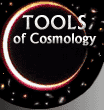
|
|
 |
Computer
Models: Tool, Theory, or What?
|
 |
|
|
|
In
the second half of the 20th century, astronomers began
to develop large computer programs. Scientists were starting to calculate
things that they could neither see with instruments, nor understand through
theoretical reasoning. The first great breakthroughs came in the 1950s
and 1960s with discoveries about the evolution of stars. Common-sense
reasoning, backed up by elaborate mathematics, had already given crude
insights into how ordinary stars like our Sun changed over billions of
years -- evolving into much larger and cooler “red giants,”
which in turn evolved into “white dwarfs.” But true understanding
came only when the ideas and mathematics were built into models calculated
by digital computers. After billions of arithmetic operations, the computers
printed out numbers that showed what happened inside a star at each stage
of its development. The results were important for cosmology, for they
gave reliable values for the ages of stars. Our Sun was about five billion
years old, and others were two or perhaps three times as old. No scientist
could get an intuitive grasp of what was happening in these computer models,
the way one might picture the workings of a mechanical clock. Gradually
scientists realized that computer models offered an entirely new way to
look at nature. This Web exhibit is displayed in two parallel streams,
“Ideas” and “Tools,” to display the parallel growth
of theory and instrumentation. Today a third, independent realm has joined
them. For example, in recent years several groups have built numerical models showing how gravity can pull galaxies together in clusters, and how the clusters themselves can map how matter was distributed at the very beginning. Repeat the calculation with a different number for the density of matter in the universe, and the results will show a tighter or looser pattern of galactic clusters. When the computers' results are compared with observations, we get important information about what kind of universe we actually live in. |
|
Copyright ©. Brought to you by the Center for History of Physics, a Division of the American Institute of Physics |
|